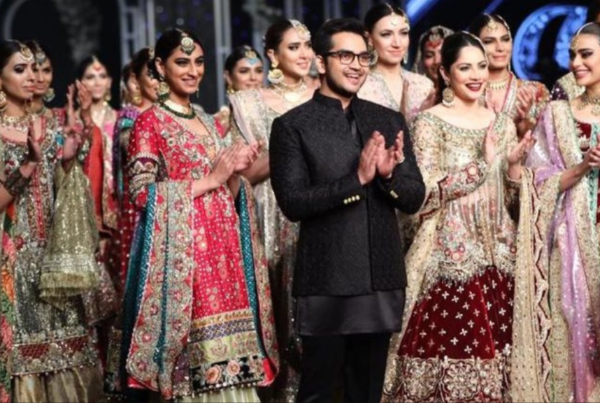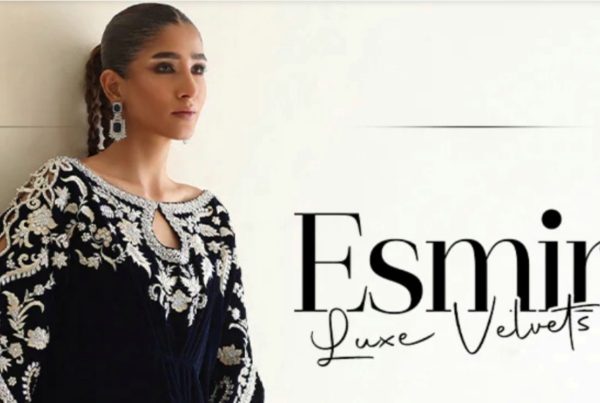Gone are the days when ‘slow and steady’ was a good mantra to win the race. It’s 2015 and the race to the top of any business has acquired an urgent restlessness, a fast and furious pace where slowing down means getting left behind or possibly falling off the bandwagon altogether. And that’s the exact pace that Wardha Saleem is gradually working towards.
Just three years into actively pursuing her design label, this IVSAA graduate just recently opened a state-of-the-art flagship store in Karachi; Wardha believes that every designer must have a nucleus to operate from. She also believes that missing one season of fashion week is equivalent to losing out an entire season of retail and moreover, there’s no point in showing if you don’t have the PR and marketing machinery to follow it through after the shows. E-Commerce, social media presence and online activity? Having a brand is pointless if it’s not making waves everywhere, especially cyber waves online.
Lucky for Wardha, she has the right attitude and a very strong social network to ensure her career unravels exactly the way she wants it to. It wouldn’t have been possible if she hadn’t such a strong support system, she agrees. As CEO of Fashion Pakistan Council, she also has the muscle to pull things through. Then again, maybe that’s why she’s CEO in the first place.
How does she manage to do it all so seemingly effortlessly? Wardha Saleem sits down with Instep and talks about it all…
Aamna Haider Isani: We’re at a time when a lot of people prefer to be online. Why do you feel that a flagship was important?
Wardha Saleem: A designer needs to have a base to operate from, especially for bridals and formals; people want that interaction. And when you are a design house you want people to actually experience the brand in its true settings. So we definitely needed a space. Luckily, we found a place that was big enough to carry prêt as well and so we decided to make it our flagship store. I feel that this should have been done before but there’s a time for everything. We’re working on our E- store now.
AHI:Â What is more lucrative for a brand these days: walk-in sales, bridals or E-commerce?
WS: Definitely E-Commerce, for pret and luxury pret. Look at a place like Dolmen Mall, for example.You have so many outlets but everywhere you look, you’ll see very few people actually buying and most of the ones buying are carrying Khaadi bags. Most of the people that come to the mall don’t come with the mindset that they have to shop. If they like something and it’s reasonable, like Rs.2500 or Rs.3000, then they would just spend on that. E-commerce is where the numbers are. Analytics reveal that women in interior Sindh and Punjab are sitting in front of their computers and shopping. E-commerce also makes it easy for clientele abroad to see the product and just order it on a click. Women don’t have much time to walk in for ready to wear anymore.
Designers are also expected to have websites and E-stores now. According to our statistics, Hyderabad is a huge market and women there are the biggest shopaholics. They read about designers, they see pictures, they follow Twitter, Instagram and Facebook ads and they buy what they like. There’s a lot of money in E-Commerce.
AHI:Â So what would you say are the building blocks to where you are today? A fashion degree, investment, showing at fashion week, having your own store, having social standing: what are the pre-requisites that got you where you are?
WS:  To be very honest, I’d say it’s everything. Even three years back when I started showing, it wasn’t as tough as it is now. The competition has really increased. Social media wasn’t that active then. Now there’s so much you have to think about before you start a brand. You have to have a social media team. You have to have your budget and marketing sorted. You have to put up shows. It’s a cycle. Your fashion week collection, showing at fashion week, your retail capacity and at the same time your publicity… so it’s not just one thing, I would say. And yes, knowing the right crowd is also very important. And that also builds up with time. Obviously when you start off, your family and friends are the ones who start investing in your brand but then it needs to grow. What I was also noticing is that a year back, there were a lot of new brands popping up. Every second house had a designer and they were doing really well, but they could not sustain. Reason being – you do your first exhibition and your friends will come, your family will come to support you.They will buy. Second time, it will decrease and it’ll keep decreasing unless you are marketing your brand properly. It has to be very aggressive.
AHI:Â What would you say is your one weakness as a designer?
WS:Â Â I stayed in a comfort zone for too long. That is why it took me so much time to open my store. The warehouse at Nishat was my own personal space; my karkhana was there and my design teams were there. But then I saw the competition getting tougher and tougher and everybody picking up in a different manner, and I said this has to be done properly. I started taking it more seriously. My brother Nubain (who handles the marketing and management of her brand) said I needed to have a flagship store. He said I needed to show at fashion weeks. He said if you want to pursue it (fashion) as your hobby, you should not be wasting so much money. But if this is your passion, then it should be done properly.
AHI: You also have a very strong support system. Your brother works with you and you have a friend like Tapu Javeri, who’s very committed to your brand. How important is that?
WS:  I think it’s very important, especially as a girl. Family and friends’ support is very important, especially because of the industry we are in. The family needs to be supportive enough where they are not restricting you. I am here today, to be very honest, because I have very strong family support. I have Nubain, who’s a great marketing guy. My younger brother is a lawyer, he’s a barrister. I have support from him also when it comes to legal issues. My mother has been very supportive, I believe in her and I trust her.
AHI:Â How much does Fashion Week help? Is it still a marketing exercise or does it actually push retail? What is the importance of Fashion Week in your story?
WS: I think nowadays, it’s very important. Fashion Week has an incredible follow up through shoots and PR and people follow the coverage and decide who’s in and who’s out. If you miss a season, the concentration will shift from you to the people who are showing. Previously, we also used to show one season and skip the next but now we know that skipping a season isn’t an option anymore. People are also much more aware now; they actually come in and ask for the new collection.
We also get a lot of international orders after fashion week. Women will see something on the ramp and want to order it immediately.
AHI: Tell us about being CEO and how you balance that job with actively managing your own brand?
WS: When I got into power, my studio was in the pipeline and I strongly needed to streamline things to handle them efficiently. It was tough in the beginning and I remember spending 12 hours a day on the fashion council. That’s all Sanam and I would do. But with time you learn. In our first year we had difficulty with sponsors and getting designers onboard. But now everything has fallen into place; it’s sorted. 45 designers applied to show at fashion week this season and we selected 21. Our sponsors are sorted and so are the media partners.
AHI:Â You changed your dates and the inconsistency bred so much speculation. It had people talking that you were unprepared.
WS:Â People talk, no matter what. Even if you do it on time, they will have something else to worry about. That is not my concern. We had too many reasons to postpone fashion week and it made perfect sense to move the dates.
We had location issues. Lahore has many beautiful locations but here we only have 5 star hotels. Other venues have technical as well as security problems.
AHI:Â But now fashion week will be happening bang in the middle of bridal season. Is that a good idea?
WS:Â All the designers showing at fashion week are targeting the coming year, not the December season. So to show in October or November would be the same thing.
AHI: You say that you selected 21 designers to show; are we to believe that there’s a selection process in place now? Several designers have been complaining that they can’t get a slot.
WS: Yes there is a process. There are some designers who we strongly feel should show and there are some designers who we need to analyze thoroughly before having them on board. Last year most of our collections were strong, except for maybe one or two. In those cases, the three pieces we saw were very interesting but what came out at the end – the entire collection – was very different. This year we haven’t gone with sketches and mood boards but have asked to see actual pieces and in some cases, the full collections. This year we have a great line up. If designers are complaining of red tape then I would say the red tape is quality control.
AHI: What about the Millennial Show? It was a really strong tradition that you started last year but don’t seem to be carrying through this year?
WS: To have a Millennial Show we needed at least six or seven students that were good enough and can you believe that we tried, but couldn’t find even six who were good and serious enough about their work. We figured this may be a bad time and we have shifted the Millennial Showcase to the Spring/Summer edition of fashion week.
– Photographs by Tapu Javeri
– This feature first appeared in Instep on Sunday




